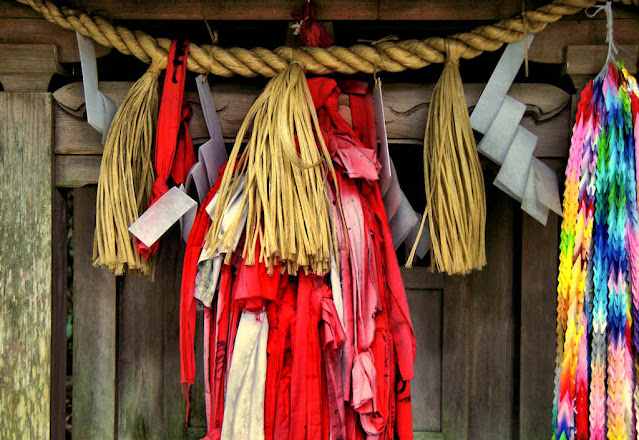Kiyama Shrine is a large shrine on the lower slopes of a mountain to the south of Maniwa in Okayama.
Above the shrine, at 430 m altitude is Kiyama Temple. Until 1868 the shrine and temple were one site called Kiyama-gu.
In 1868 the shrine and temple were separated and I believe many of the current shrine buildings date from that time.
In 1962 the shrine buildings were dismantled and reconstructed at the current site much lower down the mountain.
The Inner Shrine, the Okumiya, remained at the original site next to the temple.
It dates to the late 16th century and is a prefectural Important Cultural property. It features in the last 2 photos of this post and when I was visiting a new copper roof had been finished.
The shrine-temple complex was founded in 816 by none other than Kobo Daishi.
The shrine was known as Kiyama Gozu Tenno, a branch of what is now called Yasaka Shrine in Gion, Kyoto.
Long conflated with Gozu Tenno, the main kami is now considered to be Susano.
Gozu Tenno was also considered a manifestation of Yakushi Nyorai, the main deity/Buddha of the temple.
On the approach up to the shrine is a Zuijinmon gate with a fine pair of zuijin. Also there are a pair of fox statues.
One of the secondary shrines is Zenkaku Inari., a branch of Fushimi Inari established here in 1714 by the monk Zenkakubo.
Fushimi Inari was considered a manifestation of Kannon that was also enshrined in the main temple along with Yakushi, so we can see that the kami and the buddhas at such a syncretic site as Kiyama-gu, were very connected and/or complementary
Kiyama Shrine has an Emaden, a hall existing solely for the display of ema, votive tablets.
These ema are not the small, standard-sized boards now common at shrines and temples, but rather large paintings, see the two photos just above.
The size of the shrine and temle is an indication that it was well supported not only by local notables and rulers but also by regional warlords.
Signs on the old Izumo Kaido not far away indicate that it was also well known among a wider public
Worth looking out for are the hundreds of paper lanterns hung from the ceiling of the main hall.
Also worth noting is the unusual style of shimenawa.
I walked here from Tsuyama on a rainy summer day as Kiyama Temple was the next pilgrimage temple on the Chugoku Kannon pilgrimage.
There is no public transport to Kiyama Shrine. It is very close to the Chugoku Expressway and is near the Ochiai Interchange. The closest train station is Mimasaka Ochiai Station, 5 kilometers away.
The ox statue is in front of the Tenmangu Shrine which was probably established in the mid-19th century.
The previous post in this series on day 5 of my walk along the Chugoku Kannon pilgrimage was on
Sakura Shrine.






































































